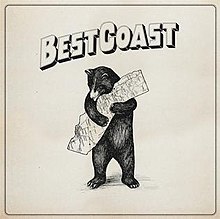The Only Place
| The Only Place | ||||
|---|---|---|---|---|
 |
||||
| Studio album by Best Coast | ||||
| Released | May 15, 2012 | |||
| Recorded | 2011–12 | |||
| Studio | Studio B, Capitol Studios (Los Angeles, California) |
|||
| Genre | ||||
| Length | 34:20 | |||
| Label | Mexican Summer | |||
| Producer | Jon Brion | |||
| Best Coast chronology | ||||
|
||||
| Singles from The Only Place | ||||
|
||||
| Professional ratings | |
|---|---|
| Aggregate scores | |
| Source | Rating |
| Metacritic | 66/100 |
| Review scores | |
| Source | Rating |
| AllMusic | |
| Pitchfork Media | 6.2/10 |
| Spin | 8/10 |
The Only Place is the second studio album by American indie rock duo Best Coast, released on May 15, 2012 by Mexican Summer. Produced by Jon Brion, the album was recorded at Capitol Studios in Los Angeles, California. The album was primarily inspired by the upheaval following the unexpected success of Crazy for You. To this end, the duo attempted to distance themselves from the lo-fi aesthetic of their first release by working with producer Jon Brion. Recorded at Capitol Studios in Los Angeles, The Only Place was inspired by 1960s country music and Fleetwood Mac.
The record received generally favorable reviews from music critics, although many reviewers were divided in their reception of the record's polished sound.
Following the release of the band's debut album, Crazy for You (2010), the band embarked upon an extensive touring schedule, which subsequently inspired the lyrical content of The Only Place. Cosentino felt that her life had dramatically changed in the two years following its release, having never spent so much time away from home. Alongside the quick, thunderous success came an intense level of scrutiny, vocal Internet haters and venom from selected critics, some of whom viewed Cosentino's material as anti-feminist.Crazy for You and its sound, "simple and pungent songs […] toying with 1950s and ’60s melodic structures," had become something of a touchstone for Best Coast and adopted by several other bands. Cosentino hid her vocals behind layers of reverb and distortion, which was an extension of her onstage anxiety. As a result, Cosentino desired to take their sophomore record in a completely different direction.
The Only Place was recorded at Capitol Records Studio B in Los Angeles, California. Cosentino and Bruno felt the production process for The Only Place was marked by a level of seriousness. While previous recording sessions were marked by goofing off and drinking, the duo took their sophomore effort more seriously and strove to create a different sound. Cosentino was reluctant to make her lyrics completely honest, but was inspired by Drake's Take Care to take a chance. "I’m going to make this record like a rapper would make it, or at least how Drake would make it," she found. Cosentino felt being more honest and relatable could better connect the listener. The record was inspired by traditional country music, which was listened to frequently during its production. Cosentino wanted to create a "weird spin on '60s country stuff like Loretta Lynn, Dusty Springfield [and] Patsy Cline." The duo also cited the Eagles and Fleetwood Mac as influences for the record. Cosentino jokingly compared the production process of The Only Place to Fleetwood Mac's Rumours (1977): "It was very epic for us. Except our studio experience was not doing cocaine until five in the morning; it was eating guacamole until five in the morning. And we had parking spaces."
...
Wikipedia
